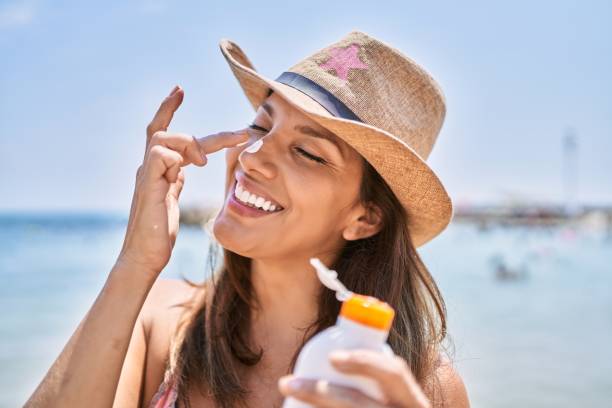
SPF: The One Skincare Step You Should Never Miss
SPF: Your Skin's Best Defence Against the Sun
Every time you step outside — even on cloudy days — your skin is exposed to harmful UV rays that can cause premature ageing, sunburn, and even long-term damage like hyperpigmentation and skin cancer. That’s why SPF (Sun Protection Factor) should be the most important step in your skincare routine — not just in summer, but all year round.
In this blog, we’ll break down what SPF really means, why it matters, and how to choose the right one for your skin type and lifestyle.
What is SPF?
SPF stands for Sun Protection Factor, a measurement that tells you how effectively a sunscreen product protects your skin from UVB rays — the type of ultraviolet radiation that causes sunburn.
Here’s how it works:
If your skin would normally burn after 10 minutes in the sun without protection, applying an SPF 30 sunscreen theoretically allows you to stay in the sun 30 times longer without burning — that’s 300 minutes. But it’s not that simple...
Why? Because sun protection also depends on:
How much sunscreen you apply
How often you reapply
Sweating, swimming, and rubbing
The UVA protection (not measured by SPF)
UVA vs. UVB Rays
To truly understand sunscreen, you need to know the difference between UVA and UVB rays:
| Type of Ray | What It Does |
Prevented by SPF?
|
| UVA | Causes premature ageing (wrinkles, sagging) |
❌ Not directly measured by SPF
|
| UVB | Causes sunburn and skin redness |
✅ Yes, this is what SPF measures
|
For full protection, look for sunscreens labeled “broad spectrum”, which means they protect against both UVA and UVB rays.
Choosing the Right SPF
What do the numbers really mean?
SPF Blocks UVB Rays
15 ~93%
30 ~97%
50 ~98%
100 ~99%
The difference between SPF 30 and SPF 50 may seem small, but it can make a big impact for those with sensitive skin, fair complexions, or conditions like melasma or rosacea.
Pro Tip: No sunscreen can block 100% of UV rays — so wear a hat, sunglasses, and protective clothing too!
Mineral vs. Chemical Sunscreen
Not all sunscreens work the same way. There are two main types:
1. Mineral (Physical) Sunscreen
Uses ingredients like zinc oxide and titanium dioxide
Sits on top of the skin and reflects UV rays
Works instantly after application
Ideal for sensitive skin
Can leave a white cast on darker skin tones
2. Chemical Sunscreen
Uses ingredients like avobenzone, oxybenzone, octinoxate
Absorbs UV rays and converts them into heat
Needs to be applied 20 minutes before sun exposure
Lightweight, more cosmetically elegant
May cause irritation for very sensitive skin types
Choose the type based on your skin sensitivity, skin tone, and lifestyle preferences.
SPF for Different Skin Types
✅ Oily or Acne-Prone Skin:
Go for oil-free, gel-based or matte finish SPF
Look for non-comedogenic and lightweight formulas
✅ Dry Skin:
Choose moisturising sunscreens with ingredients like glycerin, ceramides, or hyaluronic acid
✅ Sensitive Skin:
Mineral sunscreen is often better tolerated
Avoid alcohol, fragrances, or strong actives
✅ Dark Skin Tones:
Use invisible gel formulas or chemical sunscreens
Tinted mineral sunscreens can also help avoid white residue
How to Apply (and Reapply) SPF
Apply a nickel-sized amount to the face and two tablespoons for the body
Apply 15-20 minutes before sun exposure
Reapply every 2 hours, or immediately after swimming or sweating
Don’t forget ears, neck, eyelids, lips, and hands

Do Children Need SPF?
Yes! Children’s skin is more sensitive to UV damage. Use:
SPF 30+ or higher
Mineral sunscreens (less likely to cause irritation)
Water-resistant, fragrance-free formulas
Avoid sun exposure for infants under 6 months. Use hats and shade instead.
Do I Need SPF in Winter or Indoors?
Yes and yes.
UV rays penetrate through clouds and glass. Even if you're indoors or in a car, UVA rays can still cause skin ageing. Make SPF a daily ritual — just like brushing your teeth.
SPF & The Environment
Some ingredients in chemical sunscreens (like oxybenzone) are harmful to marine ecosystems. Look for reef-safe or ocean-friendly SPF if you’re heading to the beach.
Final Thoughts: SPF is Non-Negotiable
Don’t Skip the SPF – If you’re serious about skin health, glow, and ageing gracefully — SPF is your #1 skincare investment. Whether you prefer a tinted mineral sunscreen or a silky chemical one under your makeup, there’s an SPF formula for everyone.
Make SPF a daily habit — rain or shine, indoors or outdoors. Your future self will thank you.
Editor’s Picks: Best Types of SPF to Look For
Daily Moisturiser with SPF 30+
Tinted SPF for makeup lovers
Invisible Gel SPF for oily/combination skin
Water-Resistant SPF for outdoor activities
Kids’ SPF with mineral protection